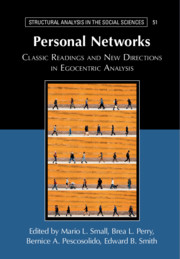Book contents
- Personal Networks
- Structural Analysis in the Social Sciences
- Personal Networks
- Copyright page
- Contents
- Figures
- Tables
- Contributors
- I Background
- II Early Foundations
- III Later Foundations
- IV New Perspectives
- 20 On Cognition
- 21 On Mobilization
- 22 On Trust
- 23 On Dynamics
- 24 On Inequality
- 25 On Culture
- 26 On Migration
- 27 On Movements
- 28 On Social Media
- Index
- Recent Books in the Series
- References
21 - On Mobilization
How Actors Mobilize Their Networks in Practice
from IV - New Perspectives
Published online by Cambridge University Press: 01 October 2021
- Personal Networks
- Structural Analysis in the Social Sciences
- Personal Networks
- Copyright page
- Contents
- Figures
- Tables
- Contributors
- I Background
- II Early Foundations
- III Later Foundations
- IV New Perspectives
- 20 On Cognition
- 21 On Mobilization
- 22 On Trust
- 23 On Dynamics
- 24 On Inequality
- 25 On Culture
- 26 On Migration
- 27 On Movements
- 28 On Social Media
- Index
- Recent Books in the Series
- References
Summary
An important reason personal networks matter is that individuals can turn to them when they have a need. But how do people decide whom in their network to turn to? Researchers across several literatures have studied this question under different rubrics, including “help-seeking behavior,” “the mobilization of social capital,” and the “activation of social ties.” The question arises when people seek social support, information about jobs, help when they are ill, advice about college enrollment, and more. The process of turning to others is ultimately a decision, and the research addressing this question has explicitly proposed or implicitly suggested the common-sense notion that, when deciding, people first assess their needs and options and then choose the best available match between the former and the latter. This idea suggests that the decision-making process is largely consistent across situations, autonomous in nature, and at least minimally deliberative. In what follows, I argue instead that, in practice, the process is heterogeneous across situations; that the heterogeneity can be characterized by the degree to which it is internal vs external, deliberative vs intuitive, and personal vs organizational; and that it can be expressed in terms of an interaction space and an institutional space of possibilities. I outline the conditions likely to shape the decision-making process in each space, and propose that the more intuitive mobilization is, the more it will depend on interaction conditions, and the more organizational it is, the more it will depend on institutional ones. I discuss the substantive, theoretical, and methodological implications of understanding decision-making in context, and propose an agenda for future work.
- Type
- Chapter
- Information
- Personal NetworksClassic Readings and New Directions in Egocentric Analysis, pp. 573 - 595Publisher: Cambridge University PressPrint publication year: 2021
References
- 3
- Cited by

